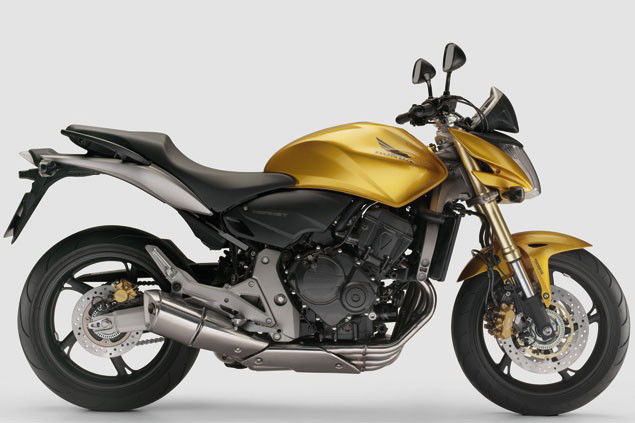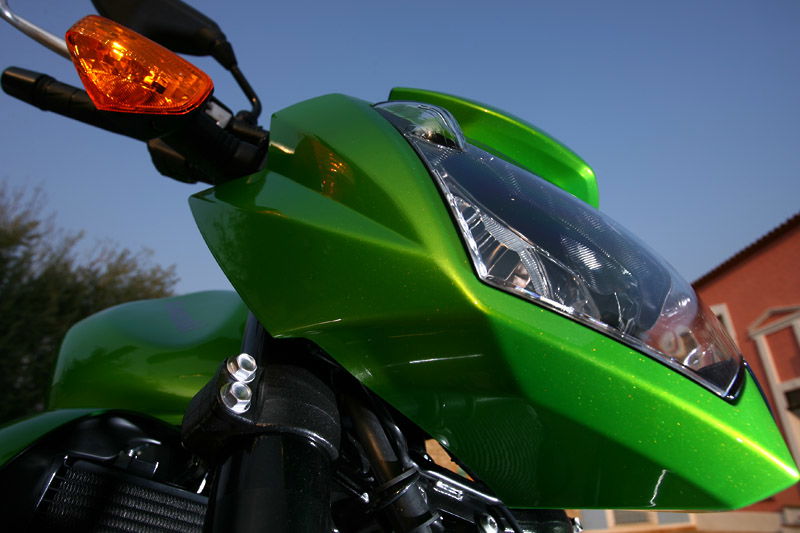Buyer Guide: Honda Hornet 600
The ultimate buyer’s guide, written by the people who actually own the bike


Click to view: Honda Hornet 600 owners reviews, specs and image galleries.
Cheap doesn’t have to mean nasty. In fact the Honda Hornet 600 offers one of the highest fun per pound ratios of any bike you can buy on the used market. But there’s more – it’s a durable, capable, useable workhorse or commuter too.
Released in 1998, it’s a winning mix of Honda’s old but extremely well proven CBR600F engine in a basic but effective chassis. It only had minor updates for the first eight years of production, has sold huge numbers all over the world and has a massive, almost cult following. It’s one of those machines that belies its price tag and components.
It handles well, it’s good in town, it’s fast if you rev it but it’s got a low seat and it’s new-rider friendly too...
Honda Hornet 600 Specifications
1998
Engine 599cc, liquid cooled, DOHC, 16-valve inline four Power 95bhp @ 12,000rpm Top speed 140mph
Torque 46lb.ft @ 9,500rpm Dry weight 179kg Seat height 790mm Fuel capacity 16 litres
2000
Engine 599cc, liquid cooled, DOHC, 16-valve inline four Power 94bhp @ 12,000rpm Top speed 140mph
Torque 46lb.ft @ 10,000rpm Dry weight 176kg (181kg) Seat height 790mm Fuel capacity 16 litres
2003
Engine 599cc, liquid cooled, DOHC, 16-valve inline four Power 95bhp @ 12,000rpm Top speed 140mph
Torque 47lb.ft @ 10,000rpm Dry weight 183kg Seat height 790mm Fuel capacity 17 litres
2007
Engine 599cc, liquid cooled, DOHC, 16-valve inline four Power 101bhp @ 12,000rpm Top speed 145mph
Torque 47lb.ft @ 10,000rpm Dry weight 173kg Seat height 800mm Fuel capacity 19 litres
Modifications
We could fill a whole magazine with Hornet modifications. While some owners keep the bike standard, most spend a fortune on different or extra parts. Over 90% of owners who helped us put this article together had modified their bike in some way. Suspension is a common target for improvement.
The standard shock’s pretty soft and lacks damping adjustment. If you’re heavy, ride fast or the bike’s done 20,000 miles of more it’d benefit from a replacement. Hagon are the cheapest (£235) and work well. Plenty of other manufacturers offer replacements right up to top end stuff like Öhlins. If you’re upgrading the rear shock it’s well worth doing the forks too. Fresh oil and new springs make a huge difference.
Again, if you’re heavy or ride fast you might want to use heavier weight oil and stronger springs. Owners are divided over whether progressive or linear springs are better – progressive ones are probably the comfort option while linear ones give consistent handling on smooth surfaces. Hugger rear mudguards, front fenda-extenders and fly screens are popular mods too. Beyond that Hornet modifying’s such a broad church you can take a bike any way you want. Some people fit whole new front ends to boost suspension and brakes in one hit. Crash bobbins are popular and useful and radiator covers add bling and belly pans and single seats give it the racer look. Some owners go the heated grips, Scottoilers and hard luggage route too if their bike are commuters or workhorses.
Tyres
When it came out, the Hornet had unusual sized tyres for a budget mid capacity bike. The huge 180-width rear and small diameter 16-inch front mirrored the FireBlade of the day. There’s a massive range of tyres available for later Hornets (year 2000 onwards) which have 17-inch front wheels and a modest selection for those early bikes with the smaller hoop. Owners of early bikes with the 16-inch front wheel may have to hunt around to get the rubber they want. For all-round use, consider the Avon Azaro ST AV45, Continental Contiforce, for sports use the Dunlop Qualifier, Bridgestone BT-014, Metzeler Sportec M3, Avon Viper Sport AV59, Pirelli Diablo (61W) and if you’re mainly doing track try the Bridgestone BT-012SS.
Those with the 17-inch front wheel can pick from pretty much any modern road going radial. Avon’s Storm ST is popular as it works well everywhere, gives good mileage and isn’t too pricey. Bridgestone BT020s and their successor, the 021 are also popular all-round rubber although some prefer the Michelin Pilot Road II. For sportier riding Metzeler’s M3 Sportec and the Pirelli Diablo are well regarded and offer more grip than a standard Hornet can exploit. If you’re after rubber on the cheap, plenty of superceded models of tyre can be had at big discounts such as Michelin Macadams and Dunlop D207 and D208s. Tyre life depends on compound and use but reckon on new rubber every 3,000 miles if you pick sporty makes and ride very hard. Gentle use can triple that figure on sports touring tyres.
Owner Case Study: "My Hornet’s frame broke…"
Sue Tym has a 1998 Hornet 600 she’s owned from new. It’s now got just over 40,000 miles on the clock. When it was four years old the frame broke, cracking right through at the wishbone, which comes down from the frame’s main spine, near the radiator and holds the engine in place.
"I had ridden home in a thunderstorm the day before. When I came to give the bike a clean with a cloth it snagged – I could see the frame had broken right through. I took the bike to my Honda dealer who was brilliant. Honda UK replaced the frame free of charge even though the bike was out of warranty. Their only condition was they could have the old one to examine it. I’m very involved in the Hornet’s Nest owners club and there’s about 4,500 owners on there. Not a single other one has had a problem with the frame breaking so I think mine was a one off manufacturing defect."
Brakes
Attacked by the press when the bike appeared for being weedy. Front twin piston calipers are okay but the first bikes (1998 and 1999) were fitted with lower friction pads to stop the brakes being too grabby as Honda wanted the bike to be learner friendly. Fitting aftermarket pads, standard ones from a later bike or a CBR600F (1995-1998) improves them significantly. EBC HH pads are highly rated by some owners as are Carbone Lorraine. Standard pads seem to be kindest to brake discs. From 2000 onwards Hornets got better pads and a metal crossover pipe linking the calipers giving improved braking performance from new. Pad life varies massively with use but an average figure is about 10,000 miles for rears and 12,000 for fronts.
Servicing
After the first 600 mile service attention’s needed every 4,000 miles in the sequence minor, intermediate, minor, major (includes valve check). Owners report costs vary from £60 at an independent for a minor to around the £300 mark for the big one at 16,000 miles at a main dealer.
Fuel consumption
Owners tell us fuel consumption varies. Yes, you can get it as low as 30mpg if you thrash the bike but steady cruising at 75mph brings it up to the mid 40s. Altering gearing (popular to boost acceleration and magnify the slightly weak torque figures) doesn’t have much effect on the bike’s appetite for unleaded. Tank range is poor, especially on the earliest machines which hold just 16 litres. Plus it’s difficult to get the tank brim full to make use of the capacity.
What goes wrong
Surprisingly little. There’s a few areas where the finish isn’t as good as owners would like but this is one robust bike. There’s the odd niggle but no real weak sports to check out. Honda’s two Achilles Heels – cam chain tensioner and regulator / rectifier can both fail but neither is costly to replace. They’re not common problems either.
If you’re looking to buy you’re far more likely to encounter problems caused by inexperienced owners such as scrapes from minor accidents, poorly maintained chains and that sort of thing. They’re popular urban transport too so theft damage isn’t out of the question too – make sure one key opens all three locks (seat, petrol cap, ignition).
Hornet culture
Being a popular bike, the Hornet’s got plenty of fans. The biggest owners club is the Hornet’s Nest, online at www.hondahornet.co.uk. They run events and get togethers plus provide huge amounts of useful information and more. Hornet 600s have had their own one make race series, run by the New Era Motorcycle Club. Its run every year since 1999 and all 600 Hornets are eligible except the ’07 injected model. It’s cheap(ish), fun and close racing.
Owner Case Study: "My Hornet’s done 68,000 miles…"
Gavin Will bought a 1998 Hornet in 2000 with 20,000 miles on the clock. It’s now covered nearly 70,000.
“I’ve been really impressed. It’s an amazing bike – much more than the sum of the parts. The only major problem I’ve had other than regular maintenance is a couple of washers in the bottom front of the engine failed and let oil into the cooling jacket – it’s not a common problem though. I’ve had to mend the radiator a couple of times with two pack glue as well. It’s my only transport and gets used all year round and it lives outside too. The finish is holding up well but I do paint it with heavy gear oil. If I was buying another I’d check for cam chain rattle – the usual Honda problem. I’d avoid tarted up bikes too. Consumables are pretty cheap – you can get genuine chain and sprockets from David Silver Spares for £48.”





